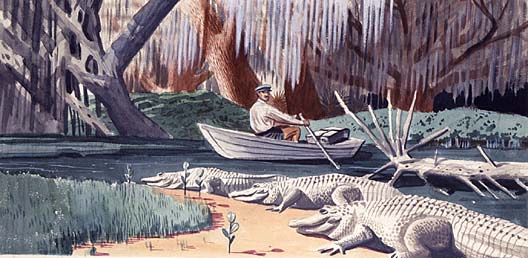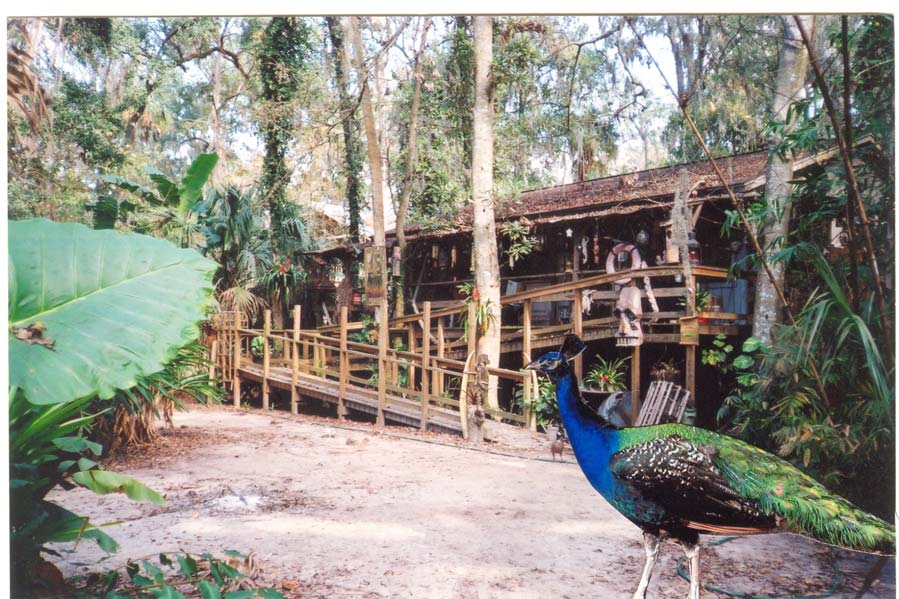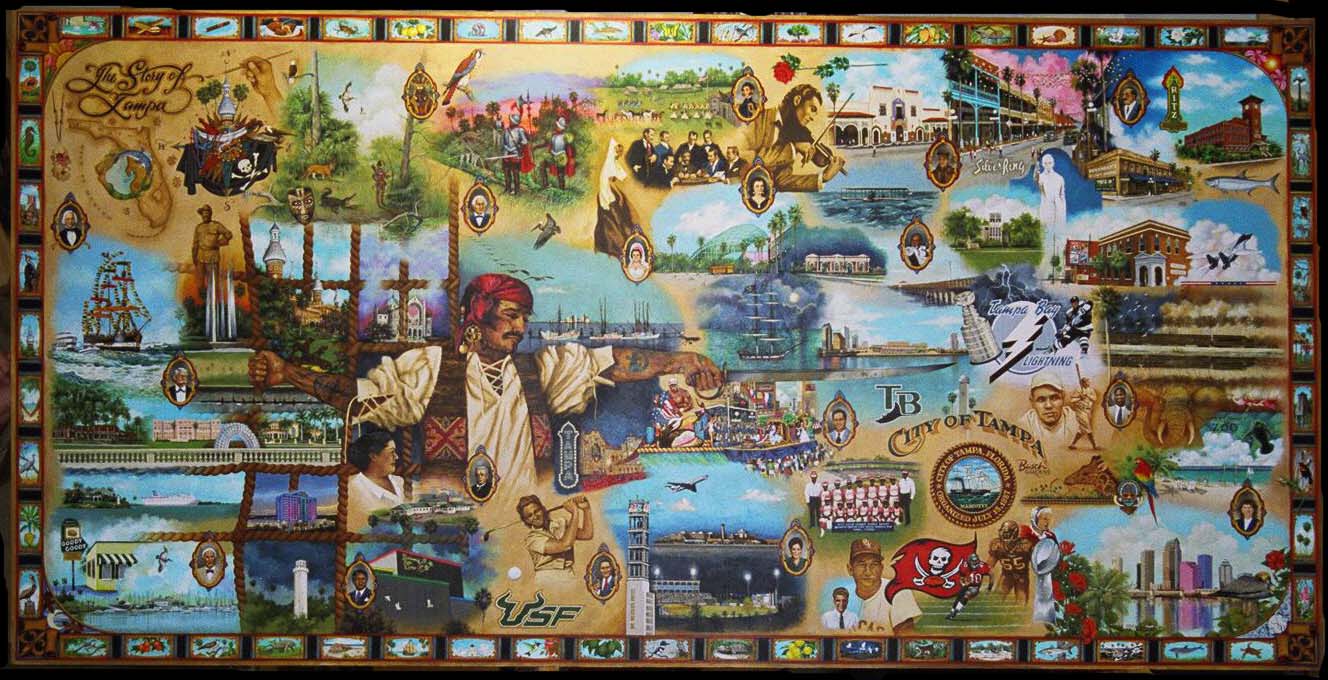|
TRAVELS OF THE BAREFOOT MAILMAN: A PAINTING’S STORY By Courtland Lewis
In 1967, American pop culture was turning a corner. It was the Summer of Love. Monterey Pop had popped things open but good. Soul was fading away and the British Invasion was starting to turn psychedelic. Beads and bell-bottoms blossomed. Sgt. Pepper’s Lonely Hearts Club Band was a phenomenon and The Who could see for miles. Former Melbourne Beach boy Jim Morrison and the Doors (of Perception) wanted you to light their fire. Jimi Hendrix was about to fill the rock sky with his intoxicating Purple Haze, while Timothy Leary urged a searching generation to “tune in, turn on, and drop out!”
In art, abstract expressionism had given way to conceptual art, minimalism, surrealism, op art, and especially the pop art of Andy Warhol and a whole palette of psychedelic graphic artists like Peter Max. Art students who might have entered school three or four years earlier thinking that rebellion meant abstraction rather than realism now faced a freeing and yet possibly bewildering array of choices for expressing their talent.
Into this tumultuous climate young painter Lynn Ash emerged from the Tampa Academy of Fine Arts. He was 24 and determined to try to be a part of art. At that time he was making ends meet by driving a produce truck between Tampa and Okeechobee for the family business. But Lynn wanted to make enough of a splash that he could be a full-time professional artist. He knew he had considerable talent as a painter, but his style leaned more toward contemporary realism—a more expressive and evocative version of traditional ways of seeing the world as it is—than toward the hip new styles.
Shortly after finishing his studies at the Academy, Lynn was urged to enter a Florida-themed painting in the Florida Federation of Art’s annual contest, held at the historic DeBary Mansion in Sanford. Although Lynn was a native Floridian, he seldom focused on Florida themes—the tropical landscape, the sudden extremes of weather, the state’s variegated history. But one piece of Florida history he had heard about intrigued him. He decided to paint the Barefoot Mailman, a legendary figure on Florida’s east coast.
Lynn painted the mailman struggling along in a tropical storm, bent over by the wind, stung by the rain, small but determined against a wind-whipped landscape. The colors were sepia, sandy beige, and a wet, dark, jungle green.
But there was a small problem. Lynn finished the painting, on masonite, the afternoon before the show; and by late that night it was still wet. So he propped it over a space heater to dry overnight. In the morning it was dry, all right, but it was also warped! The masonite had bowed into a C-shape. The competition was that afternoon—and he still had to get the thing into a frame!
Lynn tried putting pressure on the painting to flatten it; but suddenly it split down the middle! Now the painting was ruined. But Lynn was not that easily defeated. Being young and unknown, he had nothing to lose. And being resourceful, he had an idea. One half of the painting was still curved, so Lynn pressed it until it split again. Now it would finally fit into the frame—but it was clearly a broken painting. His idea was… to make this look intentional.
Lynn went out back of his house and retrieved several weathered old fence boards. He cut them to fit and mounted the framed painting on them to achieve a rustic or primitive effect. Somehow this worked, picking up the wildness of the storm and the forlorn determination of the long-ago figure pitted against it. As a finishing touch, Lynn tore a rectangular piece of brown construction paper and wrote a brief synopsis of the Barefoot Mailman story on it, and affixed this to the frame below the piece.
The painting took first prize that night.
A year later, in 1968, the American Artists’ Professional League held a contest that was hosted by the Tampa Chamber of Commerce. Several well-known painters with a national reputation, including Ben Stahl, entered. Lynn submitted “The Barefoot Mailman.”
On the way to the black-tie event, attended by Tampa’s cultural and social elite, Lynn’s girlfriend decided her white shoes didn’t go with her “Persian melon” blouse. She had Lynn stop at a hardware store so she could buy a can of black spray paint, which she deftly applied out in the parking lot. Now the shoes worked. So they continued on to the show, which they gamely endured.
Afterward, there was going to be a party at the house of a League member, at which the “best in show” painting would be announced. Lynn’s agent made him promise he would be there. But as Lynn and his friend were leaving, they decided they’d had enough of the fashionable formality and decided to run over instead to Ballast Point Pier and take a barefoot walk on the beach. Besides, Lynn figured he and his “primitive” painting didn’t have a chance against the older, renowned artists. It wasn’t until the next morning that his agent called with the news: the Mailman had again won first prize! 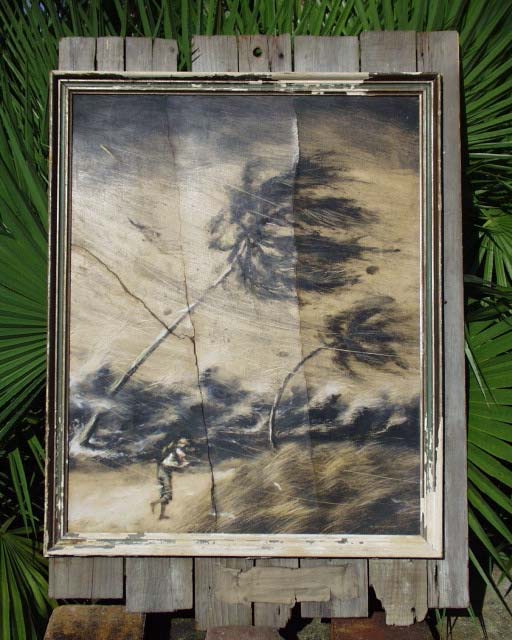
Having lived in Florida all his life, Lynn knew a lot of people. Two friends were part of a group of five young guys who owned a restaurant in Melbourne Beach. Poor Richard’s Inn was a popular hangout that had great food and a friendly, fun, informal atmosphere. All the locals loved Poor Richard’s, lin a big old Victorian house on the Indian River at the endof Ocean Avenue.
One of the guys, Mike Thall, had been to Tampa to visit Lynn around this time, and greatly admired the Barefoot Mailman painting. When Lynn came over to Melbourne Beach one weekend in late 1968 to hang out, he saw on the wall of the restaurant a big brass ship’s wheel—one of the signature objects that helped define the atmosphere of the place. Lynn was just beginning to be a collector of interesting oddities, and he had to have that wheel. He and Thall made a deal, and soon the painting was hanging in the restaurant’s main room where the ship’s wheel had been.
At this point, the painting’s history grows a little murky. Sometime in the mid-‘70s the owners of Poor Richard’s Inn had a falling-out, and eventually the restaurant closed. When the painting surfaced sometime later, it was in the hands of Frank Thomas, a retired educator with a passionate interest in the history of the Melbourne area. Thomas had become involved in an effort to preserve and restore the old, original 1891 Melbourne Beach Post Office—a small structure that had been discovered, covered with vines and crumbling away, attached to a larger house adjacent to Poor Richard’s Inn that was about to be razed. * 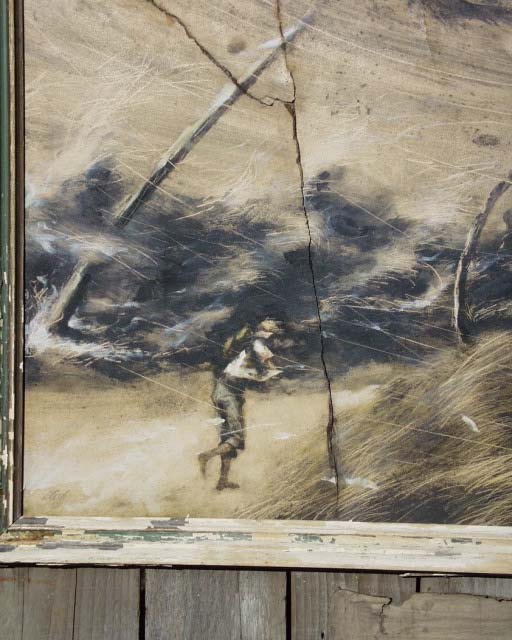
Ultimately this preservation effort failed, due to the dilapidated condition of the building. But in 1991, Thomas and other interested people organized the construction of a replica of the old Post Office, next to the modern-day P.O. across the street to the south of the restaurant’s old house. Thomas contributed the Mailman painting to hang on a wall of the replica Post Office as part of the postal history theme.
A few years later the painting was taken down and stored in a back closet of the new Post Office building along with assorted other odds and ends. There it stayed, gathering dust, until 1996, when one of the Melbourne Beach postal supervisors ordered a major spring cleaning of the Post Office building. A dumpster was brought into the parking lot and the cleanup began.
Mike Clark, a mail carrier then working in Melbourne Beach, was in the parking lot when he noticed someone carry out an odd-looking object and heave it into the dumpster. Curious, he climbed up to look and saw a painting on top of the heap. Clark pulled it out and inspected it. What he saw was strange—a framed painting broken in several places and mounted on weathered boards. But he liked it. He carried it back inside and asked the supervisor if he could have it. She readily agreed. Examining the painting more closely, Clark saw that on the lower right was printed the title, “The Barefoot Mailman,” and at the left was the name of the painter, “LAsh.” He asked around the Post Office and was told that the painting had come out of the old replica P.O. a couple years earlier. He thought that probably the boards on which it was mounted were part of a wall or door of the old building.
Clark took it home and propped it up in his den. On the back of the frame, he noticed a small card with a Tampa-area phone number. He called the number, but it was disconnected.
* The story of the replica Post Office is told, with photographs, in Thomas’ book, “Images of America: Melbourne Beach and Indialantic.” Thomas has become known as the unofficial Historian of Melbourne Beach. 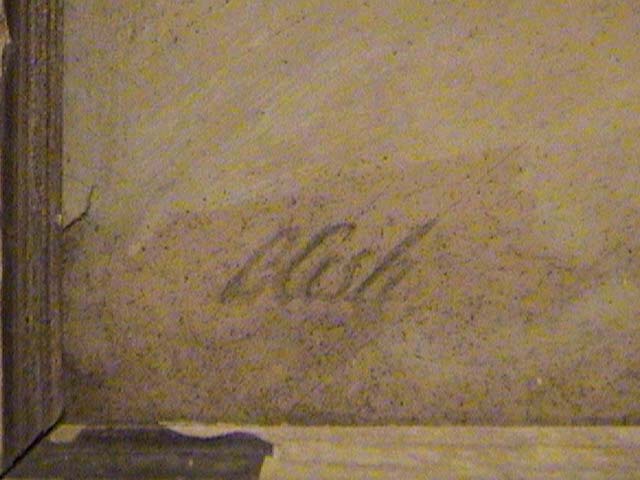 There the travels of the painting might have ended, except that Clark moonlighted as the weekend sound engineer for WMEL-AM, a local Melbourne radio station. One of the weekend shows was American Variety Radio, an eclectic weekly program hosted by the author. In January 2006, Frank Thomas came on the show to talk about Melbourne Beach history, including the old Post Office. After the show, Clark told Thomas and me about the curious painting that had come out of the old replica P.O. So many years had passed that Thomas didn’t recognize the story at the time.
A few months later, Clark sold the painting to me, and I began to research its history. Through a web search I found Lynn Ash, still painting in Tampa, and contacted him. Lynn was just finishing a mural on the history of Tampa, which had been commissioned by the City (see sidebar). He immediately remembered the painting and was amazed that it had surfaced after nearly four decades. He told me about its early history and that he was planning to paint a new version of The Barefoot Mailman for an upcoming gallery showing. I sent him some photos—“But it’s not necessary,” he said. “I remember every detail of it!” Lynn told me it was one of the first of his paintings to carry his secret, trademark brand—a small wishbone painted somewhere on the picture. “See if you can find it,” he challenged. It took ten minutes of close scrutiny, but finally I spotted it: a tiny shape hidden in the top of one of the wind-blown palm trees. The artist’s trademark wishbone is hidden among palm fronds.
Could the little wishbone have acted as a good-luck charm and protected the painting throughout its colorful life? After all, even the paper description that the painter affixed to the frame is still present—illegible now, fragile and browned, barely attached, but still there. The painting, reflecting as it does a part of Florida’s history, has perhaps now in some sense merged with that history and itself become a small part of the legend of Florida’s Barefoot Mailman.
Epilogue: Recognizing its connection to South Florida’s early history, the author donated the painting to the Historical Museum of Southern Florida, in Miami. It is now part of the museum’s permanent collection, where it will be seen from time to time and also might be included in traveling exhibitions and loaned to other museums along the old postal route. And so, the travels of “The Barefoot Mailman” will continue!
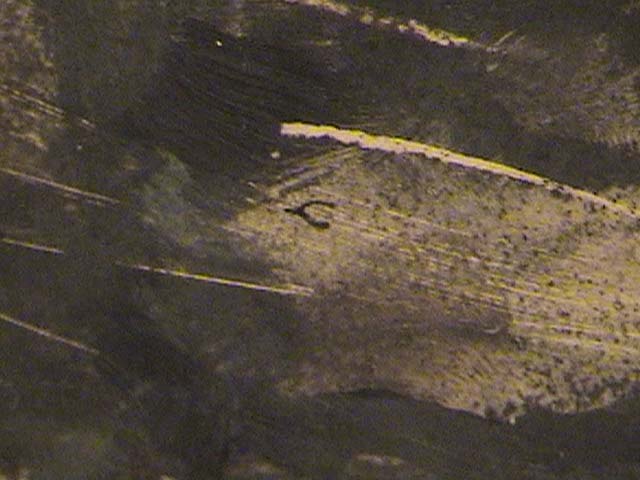 SIDEBAR
LEGEND OF THE BAREFOOT MAILMAN The Barefoot Mailman was actually a number of individuals who, between 1885 and 1892, carried the mail on the first U.S. Mail route between Palm Beach and Miami, Florida. As there was no road at the time south of Palm Beach, the carrier traveled by a combination of rowboat and walking along the beach. The mailmen walked the beach barefooted to take advantage of the firmer sand along the water's edge. Prior to the establishment of the "barefoot route," mail between Palm Beach and Miami traveled a roundabout 3000-mile route through New York and Havana, Cuba, that took six to eight weeks. The round trip of 136 miles from Palm Beach to Miami and back took six days. The carrier would leave Palm Beach on Monday morning and arrive in Miami on Wednesday afternoon. On Thursday he would start the return trip, arriving in Palm Beach on Saturday. The carriers sometimes took paying "passengers" with them, guiding any travelers who were willing to walk the beach with them. At least ten different men worked the barefoot route at one time or another. One, James E. Hamilton, died on the route. He was presumed to have drowned or been taken by an alligator while trying to swim across an inlet to retrieve his boat from the far side; his body was never recovered. Hamilton’s story was the inspiration for a 1943 novel, entitled “The Barefoot Mailman,” that led to a movie of the same name in 1951, immortalizing these intrepid federal employees in Florida history.
One of five panels of a 1939 mural depicting the “Legend of James Edward Hamilton, Mail Carrier,” which hangs in the West Palm Beach Post Office. SIDEBAR
PAINTER LYNN ASH
When Lynn Ash was in 11th grade, an article in his high school newspaper quoted him as saying, “When I graduate, I either want to work with animals or be an artist.” He has spent his life doing both. After graduating from the Academy of Fine Arts in Tampa, Ash launched his career as a commercial artist with the TTribune. In 1969, he began working at Busch Gardens as master of ceremonies for the birdshow and then was promcaretaker for larger animals, including big cats and primates. In 1982 he founded the graphics department at the theme park and became a full-time animal illustrator, painting murals asigns for all the exhibits at thGardens. In 1984 and 1985, Ash won a national zoological parksposter contest both years, and hiwinning posters were sold at all across the United States. In acclaim among zoologists and animal lovers alike when he trieto revive one of the most beloved of his charges—a 500-pound gorilla named Hercules who whaving a bad post-operative reaction to anaesthesia—usinmouth was so big that Ash clamped it shut with both hands while plugging one nostril with his thumb and blowing into the other.) The brave attempt was unsuccessful, however, and Ash mourned his friend’s death for many years. A on the side. Both his art and his love of animals took him on dozens of adventures to many of the most exotic and wildest corners of the earth in Kenya, Zaire, Egypt, Morocco, Borneo, Bali, China, Thailand, Burma, and elsewhere. A two-page sprhis life and work in the Tribune in 1992 headlined him as “Tarzan of the Arts.” The former director of the Brevard Zoo, Margo McKnight, was Ash’s colleague in the graphics department at Busch Gardens during that time. She said, “There’s no oneLynn. He can do realistic work; but he is also just such a good artist. He’s so good withcolor, getting across feelings and moods… To me, that’s his strong point as a painter.” the company of friends. 
T wild, backwoods Florida in Thonotosassa, east of Tampa. The house is outfitted and furnished in a way that redefines eclectic and evokes the Indiana Jones quality of his lOn the property is a tree house, designed to resemble the Swiss Family Robinson’s house, along with a modern-day Noah’s Ark of exotic animals and birds. Now retired from Busch Gardens, Ash devotes himself to caring for his menagerie and to pursuing his aRecently he completed a commission to paint a large mural depicting “The Story of Tampa,” which is on display in the lobby of Tampa’s City Hall. Tampa PBS station WEDU-Channel 3 will be airing a short film on his life later this year. L Former Tampa mayor and friend Dick Greco says admiringly, "If every one of us had a little bit of Lynn in us, the world would be a better place."
The guest house is suitable for Tarzan, should he swing by for a visit.
Lynn Ash’s mural, “The Story of Tampa, ”is on display in Tampa’s City Hall. |
